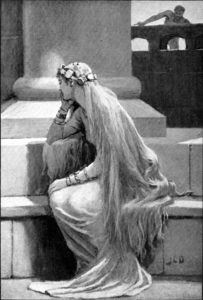
Sif by John Charles Dollman, 1909.
Sif is a female deity in Norse mythology who is known predominantly for her status as the wife of the storm god Thor, as well as being the deity who is identified with the earth. The name ‘Sif’ appears to translate to a variation of ‘relation by marriage’ which highlights the importance of her association with Thor, as well as showing that her character was never intended to be seen as an individual role. This is clear by her never appearing as more than a passing reference in the tales of others; more often than not Sif only features in the stories of her husband which cements her status as a secondary deity. She is most famed for her golden hair, which scholars have suggested may represent fields of golden wheat which relates to her position as the Nordic goddess of earth and fertility.
The earliest written examples of Norse mythology that we have date to the 13th century, although it is believed that their origins are based in the oral traditions from much earlier sources. They can be split into two prominent works; the Poetic Edda, of which there are many variations, and the Prose Edda, which was written by Snorri Sturluson.
The Poetic Edda is the modern title for a collection of anonymous Old Norse poems. There are several variations of these texts, but they all consist primarily of references to the Codex Regius which was a Medieval Icelandic text that is arguably one of the most important sources on Norse mythology. Prominent authors such as J.R.R. Tolkien (The Hobbit and The Lord of the Rings) have acknowledged the importance of this text over their work.
The Codex was written in the 13th century and as such is most likely the original example of the Poetic Edda, however as it was not rediscovered until 1643 other variations of this collection have been created. The Poetic Edda includes the narrative of the ‘Lokasenna’, a feast which showcases the disputes between Loki and the rest of the Nordic deities. Sif attends this feast in the place of her husband, who does not appear until later in the poem. This shows strong parallels to the Old English poem Beowulf which dates to around 1000CE. In this poem the character Wealhtheow, the Queen of the Danes, moves through the hall serving the warriors and defusing the conflict that arises between them. These actions are very similar to Sif in the ‘Lokasenna’ attempting to diffuse the conflicts between the deities.
Sif is also mentioned in the third chapter of the Prologue, the ‘Gylfaginning’ and the ‘Skáldskaparmál’ in the 13th century Prose Edda by Snorri Sturluson. Chapter 31 of the ‘Gylfaginning’ shows the hunting god Ullr being named as the son of Sif and the stepson of Thor, with his biological father never being mentioned by name. The details of his conception are never mentioned, so we are unaware of a reason behind why Thor is not the biological father of his wife’s child.
The ‘Skáldskaparmál’ shows Thor repeatedly defending the honour of his wife against other mythological creatures and deities. His duel with Hrungnir, the strongest of the mythological race of the Jötnar, began over Hrungnir drunkenly claiming that he wished to kill all of the Norse gods except Sif and Freyja whom he boasted he would take home with him. Thor became enraged at these claims and as a result killed Hrungnir with his Mjöllnir.
The ‘Skáldskaparmál’ also tells the story of the ‘Creation of Thor’s Hammer,’ which focused around Sif’s golden hair. In this story, Loki cuts off all of Sif’s golden hair while in a mischievous mood. Thor threatens to kill Loki as a result, but is convinced to spare his life on the condition that Loki found an even fairer head of hair for her. He did so by having a golden headpiece fashioned by some dwarves, who also created five gifts for five other deities at the same time, which included Thor’s infamous hammer, the Mjöllnir. This particular story is interesting as it is the origin story for a piece of equipment that everyone is now familiar with given the success of the Marvel franchise, but Sif and her hair are never mentioned as more than a passing reference despite being the reason behind its creation.
Overall not much is known about Sif as an independent character to her husband, which in my personal opinion, makes her very interesting. As she is a secondary figure in Norse mythology, she appears in these stories but never as a central feature while her husband is a central theme through most. Sif has been most recently portrayed in film by Jaimie Alexander in the 2011 Marvel film Thor, where she is again shown to be a secondary character to the overall story.
-Devon Allen
Junior Girl
Girl Museum Inc.
